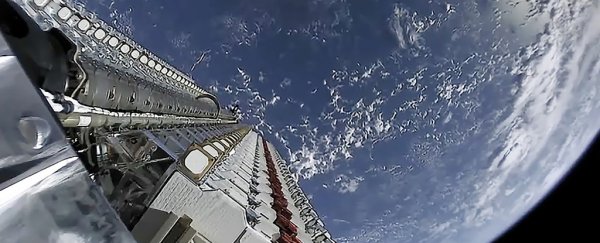SpaceX is really kicking things into high-gear with its Starlink network. The creation of this satellite constellation is central to Elon Musk's vision of providing high-bandwidth internet access to a global market.
Deployment began in earnest back in May with the launch of the first sixty Starlink satellites, with plans to launch an additional 1,584 by 2024 and 2,200 by 2027.
Until now, SpaceX's long-term goal was to create a constellation of 12,000 satellites at altitudes ranging from 328 to 580 kilometers (200 to 360 miles) – based on what the FCC has approved so far.
But according to recent filings with the International Telecommunication Union (ITU), SpaceX intends to send an additional 30,000 Starlink satellites to Low Earth Orbit (LEO) in the coming years.
Founded by the United Nations in 1865, the ITU is a specialized agency that was created to regulate information and communication technologies and facilitating international connectivity in networks.
Essentially, they are responsible for allocating portions of the global radio spectrum and satellite orbits to prevent interference and ensure communication networks are able to interconnect.
According to SpaceNews, 20 different filings were made by the FCC to the ITU on behalf of SpaceX. The filings specifically call for 1,500 satellites each, which are to be deployed at altitudes ranging from 328 to 580 kilometers (200 to 360 miles) in LEO.
Beyond that, they provide some technical specifications (like frequency usage) but do not state when SpaceX hopes to launch the satellites.
SpaceX explained this latest filing in a statement to SpaceNews:
"As demand escalates for fast, reliable internet around the world, especially for those where connectivity is non-existent, too expensive or unreliable, SpaceX is taking steps to responsibly scale Starlink's total network capacity and data density to meet the growth in users' anticipated needs."
Since ITU approval is an early step in the deployment of satellites, it is safe to say that these filings represent SpaceX's long-term plans to augment Starlink.
Originally, the company indicated that it hoped to send 12,000 internet satellites to LEO by the mid-2020s. Apparently, those plans have now expanded and involve creating a constellation that will reach a maximum of 42,000.
However, once filings are issued, SpaceX will be given a seven-year deadline which specifies that they are obligated to launch at least one satellite. This satellite will then need to operate at the specified frequencies for a period of 90 days.
And of course, the fact that SpaceX submitted 20 different filings could be seen as an indication that they may not be expecting all to be fulfilled.
In any case, if SpaceX does manage to get all of their filings approved and delivers on the constellation, it will effectively have a corner on the satellite market.
According to the United Nations Office for Outer Space Affairs (UNOOSA), there are currently 4,987 satellites in orbit around Earth, 1,900 of which are still operational.
In total, an estimated 8,378 have been launched since 1957, when Sputnik 1 became the first satellite launched..
By sending a total of 42,000 satellites to LEO, SpaceX will be single-handedly responsible for increasing the number of objects launched in the history of humanity by a factor of five.
Even for Musk, that seems a little farfetched!
This article was originally published by Universe Today. Read the original article.
